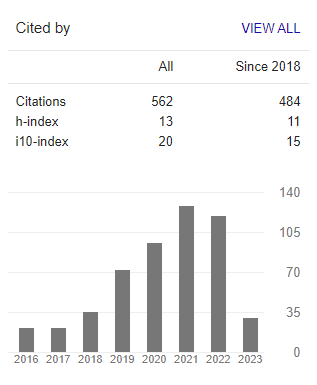DISSECTING THE GLOCALISATION OF CHINESE REALITY TV SHOWS
Abstract
The Chinese media has expanded significantly in recent years along with the country's interest in investing in emerging nations as its relations with these nations deepen and with the spread of Chinese culture through the media. Since the Chinese government began implementing substantial projects in countries in Africa, the Caribbean, and Asia, the Chinese media has been distinguished by localizing its television programming to compete with the host countries and extending their feeling of soft power to these nations. The Chinese reality television programs have remained to be a staple of the television programming in their host nations despite encountering substantial hurdles related to cultural differences and technical advancement. Despite significant pushback from the initial global dominant media in these markets, Chinese reality television series have persisted to be part of the regular host countries' television program diet. As a result, this study examines these patterns with a focus on Chinese reality television shows that have entered the host countries' markets, as well as the motive for their evolution. The paper examines the extent to which states might use these tactics to balance their domestic production while maintaining friendly relations with China. It is critical to smidgeon the evolution of this critical phenomenon in the philosophical context of product internationalization and marketization. The article addresses these difficulties by drawing attention to them from many actors in this prominent field. This study is crucial because it debunks widespread myths about reality television, such as the notion that viewers should not expect spontaneous, unscripted programming. The morality of the claimed programming of reality television programs may even be considered.
To cite this article (7th APA style):
Ong’ong’a, O. D. (2021). Dissecting the glocalization of Chinese reality TV shows. Journal Communication Spectrum: Capturing New Perspectives in Communication, 11(2), 142-150. http://dx.doi.org/10.36782/jcs.v11i2.2035Keywords
References
Armstrong, J. K. (2019, August 6). What this historical TV show reveals about China today. BBC Culture. https://www.bbc.com/culture/article/20190805-what-this-historical-tv-show-reveals-about-china-today
Cheng, F. (2019). Behind the low originality of Chinese reality TV shows: Copyright protection and government regulation for localization. Northwestern Journal of Technology and Intellectual Property, 16(4), 266-283. https://scholarlycommons.law.northwestern.edu/njtip/vol16/iss4/2
Das, S., Sarkar, P., & Hussain, A. (2021). Perception analysis of TV reality shows: Perspective of viewers’ and entertainment industry professionals. International Journal of Media, Journalism and Mass Communications, 7(2), 22-31. https://doi.org/10.20431/2454-9479.0702003
de Boer, M. L., Archetti, C., & Solbraekke, K. N. (2022). In/Fertile monsters: The emancipatory significance of representations of women on infertility reality TV. Journal of Medical Humanities, 43(1), 11-26. https://doi.org/10.1007/s10912-019-09555-z
Garrahan, M., & Sender, H. (2016, June 8). Chinese investors flood into Hollywood. Financial Times. https://www.ft.com/content/2cb93908-2c65-11e6-bf8d-26294ad519fc
Glascock, J., & Preston-Schreck, C. (2018). Verbal aggression, race, and sex on reality TV: Is this really the way it is? Journal of Broadcasting & Electronic Media, 62(3), 427-444. https://doi.org/10.1080/08838151.2018.1451859
Hill, A. (2017). Reality TV engagement: Producer and audience relations for reality talent shows. Media Industries Journal, 4(1). https://doi.org/10.3998/mij.15031809.0004.106
Ho, W. S. (2021). Chinese Supermom: Re-domesticating women in reality TV shows. Feminist Media Studies, 1-16. https://doi.org/10.1080/14680777.2021.1913433
Jiang, F. (2013). On the three waves of China's communication studies: A commemoration of the 30th anniversary of Schramm's visit to China & China's communication studies in post-Schramm times. Studies in Communication Sciences, 13(2), 107-116. https://doi.org/10.1016/j.scoms.2013.11.005
Jianguo, X., & Xin, T. (2011). Cost and fee allocation in civil procedure: China national report. Tsinghua China Law Review, 4(1), 43-68. http://www.tsinghuachinalawreview.org/newsinfo/562919.html
Kang, S., Kim, D., & Kim, Y. (2019). A visual-physiology multimodal system for detecting outlier behavior of participants in a reality TV show. International Journal of Distributed Sensor Networks, 15(7). https://doi.org/10.1177/1550147719864886
Kurnia, M. (2020). What are the elements in reality-TV shows that result in high viewership and engagement in the audience? ResearchGate. https://doi.org/10.13140/RG.2.2.35148.97928
Ong'ong'a, O. D. (2022). Dissecting the glocalization of Chinese reality tv shows. Journal Communication Spectrum, 11(2), 171–178. https://doi.org/10.36782/jcs.v11i2.2035
Pahad, A., Karkare, N., & Bhatt, M. (2015). Influence of reality television shows on society. Indian Journal of Applied Research, 5(4), 703-705. https://www.worldwidejournals.com/indian-journal-of-applied-research-(IJAR)/article/influence-of-reality-television-shows-on-society/NjM0Ng==/
Richeri, G. (2016). Global film market, regional problems. Global Media and China, 1(4), 312-330. https://doi.org/10.1177/2059436416681576
Subramaniam, R., & Kumar R., R. (2015). Impact of reality television shows on expatriate Indians in Sultanate of Oman. International Journal of Business and Management, 10(3), 177-188. https://doi.org/10.5539/ijbm.v10n3p177
Suna, L. (2018). Negotiating belonging as cultural proximity in the process of adapting global reality TV formats. Media and Communication, 6(3), 30-39. https://doi.org/10.17645/mac.v6i3.1502
Takahashi, M., Clippingdale, S., Naemura, M., & Shibata, M. (2015). Estimation of viewers’ ratings of TV programs based on behaviors in home environments. Multimedia Tools and Applications, 74(19), 8669-8684. https://doi.org/10.1007/s11042-014-2352-0
Tsay-Vogel, M., & Krakowiak, K. M. (2017). Exploring viewers’ responses to nine reality TV subgenres. Psychology of Popular Media Culture, 6(4), 348-360. https://doi.org/10.1037/ppm0000103
Weiland, S. J., & Dunbar, K. (2016). What’s real about reality television? Journal of Mass Communication & Journalism, 6(3). https://doi.org/10.4172/2165-7912.1000308
Yiming, W. (2020, January 17). Top 5 Chinese dramas that became popular overseas in 2019. China.org.cn. http://www.china.org.cn/arts/2020-01/17/content_75623198.htm
Zhang, H., Zhao, J., & Wu, Y. (2021). Disagreement and mitigation in power-asymmetrical venture capital reality TV shows: A comparative case study of shark tank in the US and dragon’s den in China. Intercultural Pragmatics, 18(2), 245-276. https://doi.org/10.1515/ip-2021-2004
Zhang, X., & Guo, Z. (2012). Hegemony and counter-hegemony: The politics of dialects in TV programs in China. Chinese Journal of Communication, 5(3), 300-315. https://doi.org/10.1080/17544750.2012.701421
Zhengrong, H., Deqiang, J., & Lei, Z. (2015). Building the nation-state: Journalism and communication studies in China. In P. Simonson & D. W. Park (Eds.), The international history of communication study (pp. 387-413). Routledge.
Zhengrong, H., Lei, Z., & Deqiang, J. (2013). Globalization, social reform and the shifting paradigms of communication studies in China. Media, Culture & Society, 35(1), 147-155. https://doi.org/10.1177/0163443712464569
Refbacks
- There are currently no refbacks.

This work is licensed under a Creative Commons Attribution 3.0 License.
Indexed by:
Archived in:
Listed in:
INTERNATIONAL ASSOCIATION FOR MEDIA AND COMMUNICATION RESEARCH

















